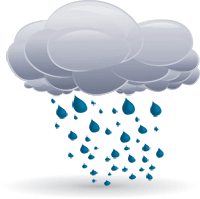2015
Wimberley Valley Radio learned on January 25, 2015, that we would be granted a license if we could build a station that met FCC standards within 1 1/2 years. In early February we selected the call letters KWVH.
The Flood
On the evening of Saturday, May 23, I received text alerts from Warn Central Texas about possible flooding. Since we weren’t on the air yet and never had more than 1-2 listeners at a time for our internet stream which was what we were limited to at the time, I turned to our Facebook page which had perhaps 3,000-3,500 followers by then to share the warnings.
About 10:40 p.m. I lost my internet service. More warnings kept coming and I called and asked Jessica Wagner, who was then volunteering to help with our Facebook page, to help. But Jessica had Time Warner and as I hoped, still had service, so I was able to forward the text messages to her and she kept posting them. A little after midnight, her service went down. Not being able to do anything further, we slept.
By 5 a.m. Sunday morning, my husband and I were up trying to get info. With our HDTV antenna, we got the news that the Fischer Store bridge was down.
On Monday, my internet was still down, but I luckily found someone who still had internet and begged to be allowed to go to her house to post information about where to get help on our Wimberley Valley Radio website.
When my internet was finally restored, I spent my time updating our Facebook page as well as our website with accurate information from official sources.
The Board and Beginnings of Getting on the Air
In the meantime, the board and I were emailing frequently. Mac McCullough who was on the City Council then as well as on our board gave us updates on the city’s response and what it was like trying to convey accurate info to those trying to clean up debris at their devastated homes, a three hour process, if I recall correctly, only to find that information had changed during the time he’d been taking it to people on his route.
By late Friday night, Mac texted that we had to ‘Get off our butts and DO something.’ Until then, I’d been living with the frustration that we didn’t have a radio station to provide our community with the info they needed.
That galvanized the board and changed our thinking from what we couldn’t do to thinking we MUST get on the air, ASAP.
On Saturday morning, I texted a mentor, Jim Ellinger with Austin Airwaves, and said we needed his help to get on the air. Mike August, a broadcast engineer who was participating in our organizing meetings, volunteered to drive into Austin to pick up Jim and another broadcast engineer with Austin Airwaves, Jerry Chamkis, along with a radio transmitter, antenna, co-ax cable, and other equipment.
By early afternoon, they were driving back to Wimberley with Jim texting about the weather and giving updates. The plan was to erect a temporary radio broadcast setup at Mac McCullough’s house on top of Paradise Hill. Mac was a ham radio operator and had given us permission to use his tower for our antenna, plus add our equipment to the room where he kept and used all his ham equipment.
They were temporarily stymied by a deputy preventing them from crossing the low water crossing at Climbing Way due to flooding. They figured there had to be a back way, and found Spoke Hollow, aiming for the antenna they could see. Jim Ellinger jumped out of the car with a bag of equipment and started trekking up the hill toward the antenna. As he approached it, he suddenly realized that coming up on someone like he was high lead to someone defending themselves with a gun so he texted me, and I called Mac. They got to work right away. Because of lightning they avoided the shortwave radio tower and instead made a temporary wooden mast for the antenna.
By early evening that same day, they had a working broadcast signal and texted me and some other volunteers asking if we wanted to come up and initiate the broadcast. Several of us, including DuAnne Redus and David Harrison, went up to Mac’s. The weather had finally improved and the low water crossing was open. I broadcast a message Jim suggested, ‘You are listening to KWVH 94.1 FM and if anyone can hear our signal, please let us know on our Facebook page and tell us where you are.’” We had our FCC-approved broadcast engineer, Michael Brown, begin work right away to get us an emergency license. But at first they refused since our equipment was not up to technical specifications required for our location, and also they no longer allowed emergency licenses.
Senator John Cornyn had taken a tour of the devastation and Mac McCullough had the opportunity to talk to him. Senator Cornyn asked how he could help and Mac told him we needed help getting the FCC to approve us for broadcasting. He had his staff intervene with the FCC.
By Wednesday, June 3 the FCC figured out a type of approval they could give us and we proceeded to start broadcasting. That approval was for 30 days.
A then-board member, Rich Thibodeaux, programmed a laptop to stop at the top of every hour and give the legal ID required by the FCC, “This is KWVHLP 94.3, Wimberley, Texas.”
We got the antenna specified by our radio license, rented a “cherry picker” and installed it on Mac McCullough’s ham tower.
On February 25, 2016 we were notified that we were granted our full broadcast license.
The rest is history.






